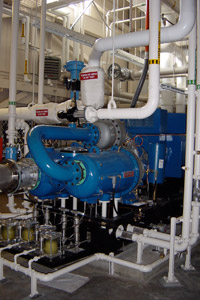Compressed Air System Audit
 The word audit is often maligned as it generally conjures up thoughts of the IRS or other painful experience. However, in the world of finance and other areas of corporate business, audits are looked upon as a way of making sure all of the required procedures are being followed and provides a necessary check on the system to give a third party perspective to these routine operations. These audits are conducted by outside parties and are typically carried out on a annual or semiannual basis. The CFO budgets for them and looks to them to show their system of accounting and record keeping are up to date and operating correctly. It should be no different for a facilities manager with his various plant systems. Auditing should be a line item in the facilities budget so the various systems can be checked and analyzed to make sure they operating as they were originally designed and to make certain there are not procedures which are out of date or improvements which can be made to improve the bottom line. This approach applies across the board to process equipment, central plant operations, maintenance procedures, as well as air, steam, chilled water, process water, HVAC, lighting, and other systems. There are many sources for the experts who can provide these services and the prices range from free (usually from vendors) to tens of thousands of dollars.
The word audit is often maligned as it generally conjures up thoughts of the IRS or other painful experience. However, in the world of finance and other areas of corporate business, audits are looked upon as a way of making sure all of the required procedures are being followed and provides a necessary check on the system to give a third party perspective to these routine operations. These audits are conducted by outside parties and are typically carried out on a annual or semiannual basis. The CFO budgets for them and looks to them to show their system of accounting and record keeping are up to date and operating correctly. It should be no different for a facilities manager with his various plant systems. Auditing should be a line item in the facilities budget so the various systems can be checked and analyzed to make sure they operating as they were originally designed and to make certain there are not procedures which are out of date or improvements which can be made to improve the bottom line. This approach applies across the board to process equipment, central plant operations, maintenance procedures, as well as air, steam, chilled water, process water, HVAC, lighting, and other systems. There are many sources for the experts who can provide these services and the prices range from free (usually from vendors) to tens of thousands of dollars.
A compressed air system audit involves inspection, analysis, and review of all aspects of a plant compressed air system. The fundamental purpose is to find the cause of any system deficiencies and identify inefficient uses of compressed air. Recommendations for improvement are made along with the expected economic impact from these recommendations. Elements of an air system audit usually include, but are not limited to:
 Point of use analysis: Review of all major points of use for proper and appropriate air use.
Point of use analysis: Review of all major points of use for proper and appropriate air use.- Air treatment equipment: Examination and analysis of aftercoolers, moisture removal/separation equipment, system dewpoint requirements, and testing (when possible) of purge air dryers.
- Plant pressure profile: precise measurement of system pressures at strategic locations throughout the facility.
- Plant air piping: review of sizes and layout of piping and storage along with any recommended changes.
- Report: all of this information is compiled in a concise report which gives specific recommendations and economic justification.
 Airometrix is not affiliated with any compressor or other equipment manufacturer and does not sell or manufacture any equipment other than the LP Series of flow meters. We work with the facility personnel to identify a supplier for equipment or services to implement recommended projects and we are also available to help evaluate proposals received if required.
Airometrix is not affiliated with any compressor or other equipment manufacturer and does not sell or manufacture any equipment other than the LP Series of flow meters. We work with the facility personnel to identify a supplier for equipment or services to implement recommended projects and we are also available to help evaluate proposals received if required.
Our approach to training, testing, and auditing of systems is a fact-based approach which first aims to determine not just the quantity of compressed air being produced, but also the efficiency and performance characteristics of that production. Only once we understand how the air is being produced and supplied do we venture into the system to understand how the air is being used and make recommendations. It is very difficult to make a proper diagnosis of the system while only knowing half of the equation.